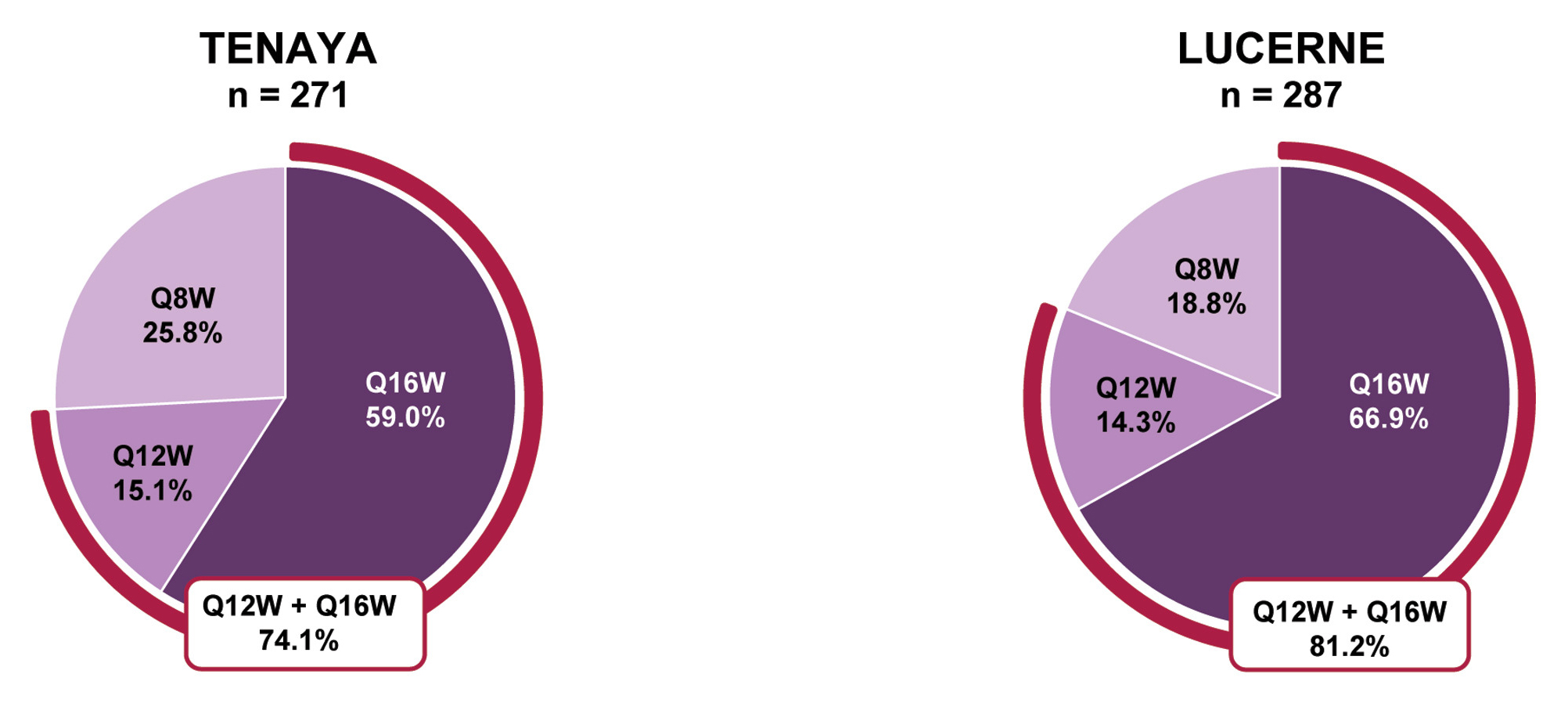In early 2022, a newly approved anti-VEGF drug faricimab (Vabysmo, Genentech) emerged as a novel treatment option for age-related macular degeneration (AMD), as well as diabetic macular edema, extending the treatment interval to once every three months. Clinical trials previously evaluated the safety and efficacy of faricimab through one year for each disease. The TENAYA and LUCERNE trials that led to FDA approval looked specifically at the drug’s effect on neovascular AMD, in which patients with this condition were treated up to every 16 weeks compared with aflibercept every eight weeks. Both trials met their primary endpoint of noninferiority in mean change from baseline in best-corrected visual acuity (BCVA) at one year with faricimab compared with aflibercept.
An extension of these trials recently evaluated the two-year outcomes using a treat-and-extend protocol based on disease activity for faricimab treatment in neovascular AMD. This approach to treatment is used frequently in practice across care of other diseases and benefits patients by potentially reducing their visits to the office and burden of treatment. Fortunately, results of this study—published yesterday in Ophthalmology—found evidence to suggest that personalized faricimab dosing doesn’t appear to sacrifice vision gains and may be a possibility for patients with neovascular AMD.
 |
| Proportion of patients in the Q16W arms who achieved Q8W, Q12W or Q16W dosing at the conclusion of the study. Pooling 12- and 16-week data shows that roughly three-quarters were able to extend their interval into the three- to four-month range (74.1% in TENAYA and 81.2% in LUCERNE). Photo: Kotecha A, et al. Ophthalmol, Feb. 19, 2024. Click image to enlarge. |
Of 1,326 patients treated across the TENAYA and LUCERNE trials, 1,113 (83.9%) completed this extended study (555 in the faricimab group and 558 in the aflibercept group) and were randomized 1:1 to faricimab 6.0mg up to Q16W after four initial doses given every four weeks (Q4W) or aflibercept 2.0mg Q8W after three initial doses given. The researchers explained further in their paper that, “after the initial four doses, patients in the faricimab arm were treated Q16W, Q12W, or Q8W through week 60. Dosing decisions in the first year were determined by a strict set of protocol-defined disease activity criteria at weeks 20 and 24 based on anatomical and BCVA measurements.” After week 60, faricimab-treated patients followed a treat-and-extend-based regimen up to week 108 in which dosing intervals were adjusted based on prespecified criteria of BCVA, central subfield thickness determined on SD-OCT and/or presence of new macular hemorrhage.
“In brief, dosing intervals could be extended by four weeks (up to Q16W) if the patient achieved stable anatomy, vision, and no new macular hemorrhage. The interval was reduced by four- or eight-week increments (as low as Q8W) if there was worsening vision or anatomy or new macular hemorrhage,” the researchers wrote in their paper on the study.
The results showed that in both trials, vision gains were maintained through year two in neovascular AMD patients treated with faricimab using treat-and-extend protocol. At two years, BCVA change from baseline was comparable between the faricimab and aflibercept groups in the TENAYA trial (adjusted mean change: +3.7 letters and +3.3 letters, respectively) as well as the LUCERNE trial (adjusted mean change: +5.0 letters and +5.2, respectively).
Additionally, most patients achieved extended dosing intervals: at two years, 59.0% and 66.9% of patients in TENAYA and LUCERNE, respectively, achieved faricimab dosing of every six weeks, up from year one’s proportion of around 45%. Finally, 74.1% and 81.2% achieved ≥Q12W dosing by year two, respectively.
“Following the transition to the T&E-based personalized treatment interval, a treatment regimen that reflects clinical practice as closely as possible, more faricimab-treated patients achieved extended dosing intervals (~80% ≥Q12W dosing, >60% Q16W dosing),” the study authors reported in their paper.
“The comparable vision gains through year two in the faricimab arm were achieved with fewer injections than with aflibercept,” they continued. “In TENAYA and LUCERNE through year two, the median number of faricimab injections was 10 compared with 15 aflibercept injections.” Specifically during the treat-and-extend-based treatment phase, after week 60, a median number of three faricimab injections were administered compared with six aflibercept injections through year two.
Ocular adverse events in the study eye were comparable between faricimab and aflibercept through two years in both trials (TENAYA, 55.0% and 56.5% of patients; LUCERNE, 52.9% and 47.5% of patients).
Overall, these two-year results demonstrate that the positive effects of faricimab in neovascular AMD treatment are maintained through year two, with more faricimab patients achieving and maintaining a Q16W dosing regimen and, consequently, needing fewer injections.
“These data support dual Ang-2/VEGF-A inhibition with faricimab as a novel approach to target the Ang-Tie2 and VEGF-A pathways involved in nAMD pathogenesis, leading to durable efficacy, giving physicians the potential to extend time between treatments without compromising vision or anatomic outcomes,” the researchers concluded in their paper.
Kotecha A, Chang A, Willis JR, et al. TENAYA and LUCERNE: 2-year results from the phase 3 nAMD trials of faricimab with treat-and-extend dosing in year. Ophthalmology. February 19, 2024. [Epub ahead of print]. |

